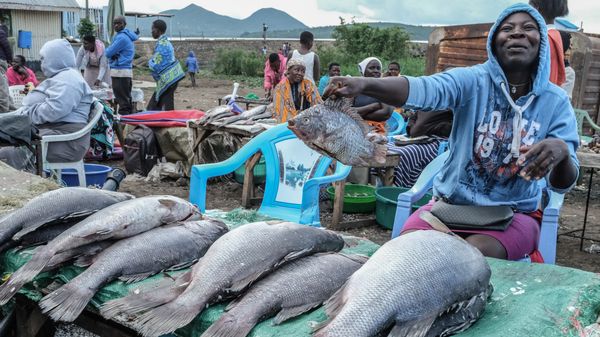By Spy Uganda
The first thing you will need to start a small-scale fish farming business is some basic knowledge about raising fish. To raise fish you will need some space for digging a fish pond. Fish can also be raised in any kind of fish tanks, containers, and tubs.
Before you start fish farming, there are several basic considerations to ensure success and these include:
The Fish Pond Design
When deciding on the fish pond site and design, there are some key factors to be considered and they include;
Source of water to fill the pond and how the same water will be brought to the pond:
- The general rule is that the pond water inflow and outflow should equal the pond volume over the period of a month.
- If the inflow is too low, water quality may suffer from oxygen depletion and/or accumulation of toxicants.
- If the water outflow is too high, large amounts of beneficial algae may be flushed out from the pond.
- The water should keep the pond full throughout the culture period. The pond should fill up in less than a week.
- Place screens on pond inlets and outlets to keep out predators, insects, and unwanted fish and also to retain the cultured fish.
Size, Shape & Depth Of The Pond:
- Relatively shallow ponds are productive. However, the shallow end should be at least 0.5m deep to avoid invasion by weeds and predation of the fish.
- The size and shape of the pond can vary depending on the fish species, fish population, and the farmer’s preferences.
- It’s worth noting that if you want to produce fingerlings, you will require more small ponds whereas a food fish producer requires relatively large ponds.
The Slope Of The Pond Bottom:
- The bottom must have a sufficient slope for good drainage.
- A slope with a drop of 2cm for every 10m along the pond bottom is appropriate.
- If the slope is too gentle, the pond will not be easily drained.
- If the pond is too steep, it may be too shallow at one end or too deep at the other end. The pond should be drainable.
Height, Width & Slope Of The Dyke:
- The perimeter and feeder roads are required for movement of machines during construction and harvest.
- If you plan to drive on the dykes, build them at least 3m wide on top and at the base.
Suitable Species
There are three major fish species which can do well in the East African climatic conditions. They are Nile perch (Lates niloticus), Nile tilapia (Oreochromis niloticus), African catfish (Clarias gariepinus) and Trout
Nile perch
One of the largest freshwater fish, Lates niloticus reaches a maximum length of nearly two meters (more than six feet), weighing up to 200 kg. Mature fish average 121–137 cm although many fish are caught before they can grow this large.
A fierce predator that dominates its surroundings, the Nile perch feed on fish (including its own species), crustaceans, and insects; the juveniles also feed on zooplankton.
Tilapia
This is a warm water fish and is mainly cultured in a freshwater environment. It thrives well in water temperature of between 20-35 degree Celsius. It attains sexual maturity at two months. Tilapia feed lower in the food chain i.e. feeds mainly on phytoplankton, zooplankton, and detritus.
Stocking rates range from two to six fingerlings/m2, depending on the level of management. Male tilapia are known to grow almost twice as fast as females.
It is, therefore, preferable to stock only males (monosex culture) to achieve the fastest growth and reach market size in the shortest possible period, resulting in more proteins and profits. A major management problem of pond-cultured tilapia is an excessive reproduction and the subsequent stunting of fish due to overcrowding.
Methods of controlling overpopulation include manual sexing of fish, use of sex-reversal hormones to produce all males, and use of predators.
The success of these methods may rest with how well a fish farmer understands the techniques.
Catfish
It grows in the same agro-climatic regions as tilapia. The water temperatures of between 26-33 degrees Celsius are ideal. It attains maturity at two years of age or at 200-500 grams. It feeds mainly on zooplankton. Their stocking rate is 100-450 fry/ m2.
Catfish has a drawback of high mortality of fry especially during the first 14 days after eggs hatch
Trout
It’s a cold water fish and it’s best grown in high altitude regions where water is cooler. Its presently limited by the availability of seeds and quality feeds in the country.
Fish feeds
There are various feeds that can be offered to the fish in the pond. Some commonly available feeds include:
- Meals
- Crumble
- Dry sinking pellets
- Moist sinking pellets
- Floating pellets
The feeds can be formulated so as to meet the body requirements of the fish species. This can be done as follows:
i. Cottonseed cake— 37%
ii. Wheat bran— 57%
iii. Fresh shrimp— 6%
iv. Vitamin Premix
Feed ingredients can be hand ground or a manual grinder can be used. It’s important to adhere to the four fixes (4Fs) when feeding fish. These are:
- Fixed feed quality.
- Fixed feed quantity.
- Fixed feeding location.
- Fixed feeding time.
The fish should be fed between 10 am and 4 pm when the water temperatures and dissolved oxygen content are reasonably high and the fish are active.







